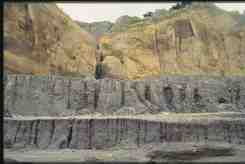 |
At dawn on June 15, 1991, a cataclysmic eruption began with a tremendous explosion
that destroyed ten deserted villages. This eruption deposited approximately 5 to 7
km3 of volcanic fragments in pyroclastic flows on the slopes of the volcano and over
neighboring towns and agricultural areas. It is this material that continues to threaten
structures and lives in the area, in the form of lahars (debris flows) during heavy
rainstorms. The lahars from the Mount Pinatubo volcano have been particularly damaging
to the surrounding area. This set of slides shows how the disaster that began at Pinatubo
in 1991 continues to threaten the population in the area. Mount Pinatubo is located
on the Island of Luzon in the Philippines, about 100 km northwest of Manila. The volcano,
with K-Ar datings of approximately 1.1 million years, and with the youngest carbon-14
dating of + 400 years B.P. (before present), is the youngest volcano in the western
Luzon volcanic arc. On April 2, 1991, Pinatubo, which had been rumbling for months,
stirred to life. Over the next six weeks earth tremors and minor explosions occurred.
These natural warnings led to the evacuation of personnel at Clark Air Base and of
55,000 people in nearby towns and villages. At dawn on June 15, 1991, a cataclysmic
eruption began with a tremendous explosion that destroyed ten deserted villages. The
eruption deposited approximately 5 to 7 km3 of volcanic fragments in pyroclastic flows
on the slopes of the volcano and over neighboring towns and agricultural areas. It
is this material that continues to threaten structures and lives in the area, inthe
form of lahars (debris flows) during heavy rainstorms. The Pinatubo deposits are subdivided
into two general groups based on the lithology and age of emplacement: the "ancestral"
and the "modern." The ancestral Pinatubo (+/- 1 million to +/-35,000 years B.P.) is
an andesite-dacite stratovolcano of mostly laval flows and breccia deposits oflaharic
origin. On its slopes are numerous elongated to sub-rounded hills made up of breccia,
created mostly by the ancestral lahars. The modern Pinatubo (+/- 35,000 years to present)
shows signs of repeated, very explosive eruptions which have produced large volumes
of pumiceouspyroclastic flows. Pyroclastic flows, also known as nuee ardentes, or
glowing avalanches, are extremely hot (+/-1,000 degrees Celsius), often incandescent,
highly fluid, gravity-driven density currents of gas and volcanic fragments that sweep
down slope and travel at hurricane speed (+/-100 km per hour). Pyroclastic flows are
generated when the density of the rising column of volcanic fragments and gas exceeds
that of the surrounding atmosphere. Gravity causes a portion or all of the column
to collapse and flow down the flanks of the volcano. Most of the 1991 pyroclastic
flow deposits were emplaced during the June 15 eruption. The pre-eruption magma temperature
of Pinatubo was about 800 degrees Celsius and the temperature of the emplaced pyroclastic
flow was on the order of 600 degrees Celsius. The deposits are non-welded, dry, and
very loose. The accumulated thickness of the pyroclastic flows varies, depending on
the proximity to the crater and the pre-eruption morphology. It reaches more than
200 meters along deep pre-eruption valleys. The pyroclastic flow deposits of 1991
affected eight major watersheds around the slopes of the volcano and radically altered
the hydrological regimes, leading to unprecedented amounts of erosion and sediment
delivery in the form of destructive lahars. Lahars predominantly occur during the
rainy season in the monsoon period, which lasts from June until November. Long-duration
and high-intensity rainfall, associated with the occurrence of strong typhoons, are
responsible for the production of large-magnitude lahars. Other factors contributing
to the rapid erosion of lahars are: failure of lahar dams, secondary explosions produced
by rapid vertical and lateral erosion of the pyroclastic flow deposits, and stream
and river capture bringing deposits into new drainage systems. The rapid erosion or
removal of the pyroclastic flow deposits has been one of the major social and scientific
concerns after the 1991 eruption ofthe Pinatubo Volcano. The lahars from Pinatubo
have resulted in loss of lives and damage to properties in areas surrounding the volcano.
About 500,000 persons were left homeless and indirect impacts such as flooding and
isolation have affected more than 1.3 million people in 39 different towns and four
large cities. About 1,000 km2 of prime agricultural lands are atrisk. Lahars will
continue to be an important hazard on the lower slopes of Pinatubo for a number of
years. |